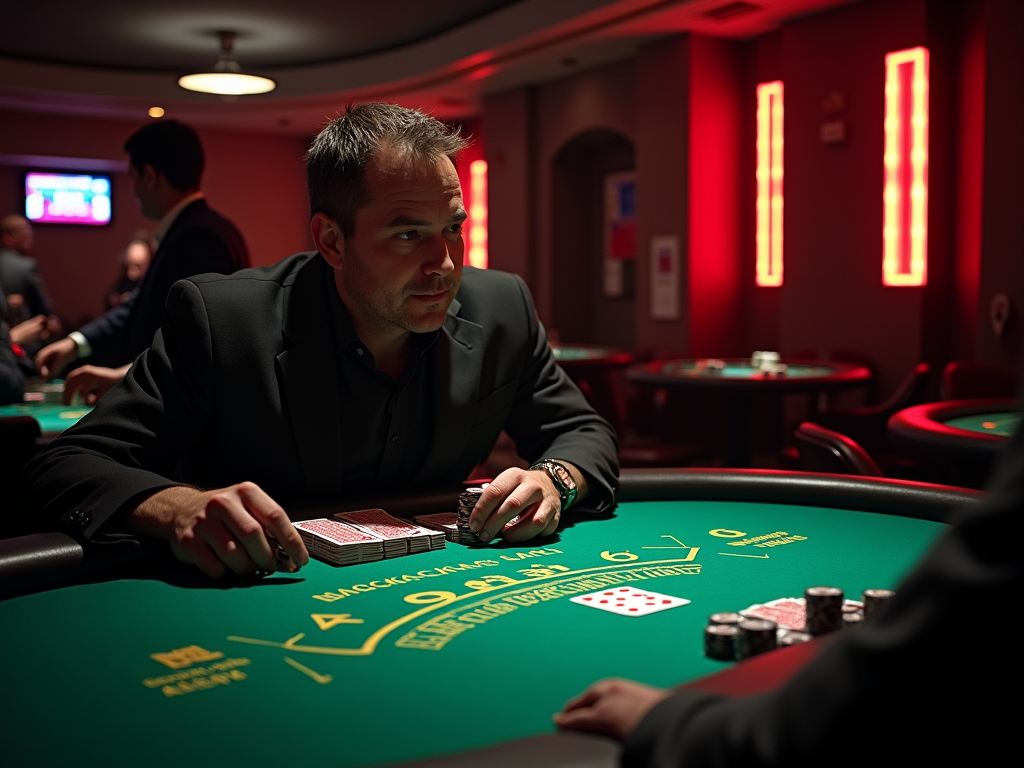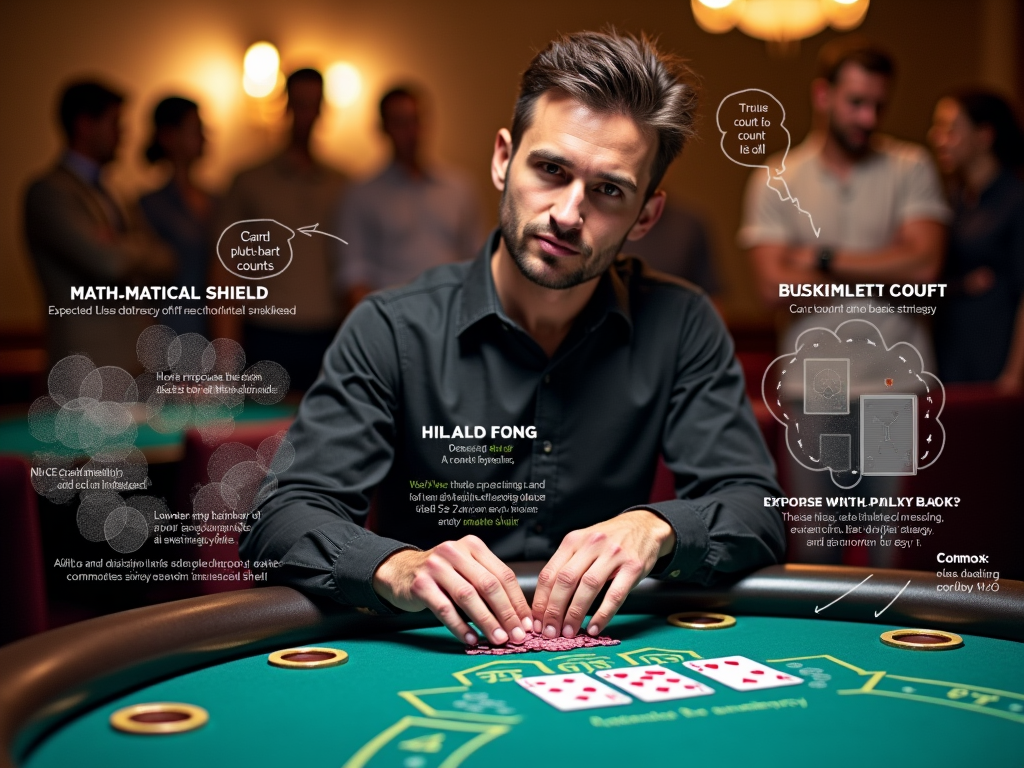Mastering Blackjack Strategy for Long-Term Success
Blackjack success stems from mastering proven strategies that cut the house edge from 2–2.5% to about 0.5%. I implement mathematically sound decisions paired with smart bankroll management and selective table choice to boost winning odds while limiting losses.
Key Takeaways
- Always follow basic strategy rules like splitting Aces and 8s, never splitting 5s or 10s, and standing on hard 17 and above
- Look for tables with player-friendly rules like 3:2 payouts and dealers standing on soft 17
- Avoid common mistakes like taking insurance bets or relying on progressive betting systems
- Maintain proper bankroll management by betting 1–2% of your total funds per hand
- Practice effective table communication using standard hand signals for all playing decisions
Consistent Strategy Leads to Consistent Results
My experience shows consistent adherence to basic strategy delivers the best long-term results. I focus on tables offering favorable rules while steering clear of common pitfalls that erode player advantage.
Smart bankroll management protects my funds during downswings, letting me capitalize on good runs. Clear dealer communication through standard signals keeps play smooth and efficient.
Win More at the Tables: The Math Behind Basic Strategy
I’ve discovered that applying basic strategy is one of the most effective ways to cut down the casino’s advantage in blackjack. Through extensive computer simulations analyzing millions of hands, basic strategy has proven to reduce the house edge from 2-2.5% to approximately 0.5%. That’s a significant improvement that can help protect your bankroll.
Core Strategy Rules That Matter
Let me share some fundamental rules that form the backbone of basic strategy. These aren’t random suggestions – they’re mathematically proven decisions that give you the best chance of winning:
- Always split Aces and 8s – this maximizes your winning potential
- Never split 5s or 10s – these hands are stronger as they are
- Hit on hard 16 when the dealer shows 7 or higher
- Double down on 11 against dealer’s 2-10
- Stand on hard 17 and above
The Financial Impact of Strategy
The financial benefits of using basic strategy in card games are clear. Let’s break down a typical session: If you’re playing 100 hands with $10 bets, you’d likely lose around $20-25 without using any strategy. However, by applying basic strategy correctly, those same 100 hands might only cost you about $5 in expected losses.
Table rules can also shift the math in subtle but important ways. For instance, whether the dealer hits or stands on soft 17 (known as H17 vs S17) changes the house edge by roughly 0.22%. I always check these rules before sitting down at a table because they impact my overall chances of winning.
Think of basic strategy as a mathematical shield – it won’t guarantee wins, but it gives you the strongest defense against the house edge. Just like in other casino games where betting systems matter, having a solid foundation in blackjack’s basic strategy puts you in the best position to succeed.
The beauty of basic strategy lies in its simplicity once you’ve learned it. You don’t need to count cards or use complex systems – you just need to make the mathematically correct decision for each hand. With practice, these decisions become second nature, allowing you to play confidently and minimize your losses while maximizing your winning potential.
Remember that basic strategy isn’t about getting lucky – it’s about making the statistically best choice every time. Even when it feels wrong to hit that 16 against a dealer’s 10, the math proves it’s the right long-term play. By sticking to these proven principles, you’ll be playing blackjack the smart way.
Master Card Counting: From Basics to Advanced Play
Card counting isn’t just for math geniuses or movie characters – it’s a skill that can enhance your casino table games strategy with practice and dedication.
Understanding the Hi-Lo System
The Hi-Lo counting system stands out as one of the most effective methods for gaining an edge at blackjack. Here’s how I break down the card values:
- Cards 2 through 6 are assigned a value of +1
- Cards 7 through 9 count as 0
- 10s through Aces are counted as -1
The magic happens when you track these values throughout gameplay. As cards are dealt, I maintain a running count by adding or subtracting based on each card’s assigned value. This running count transforms into a true count by dividing it by the number of decks remaining in play.
This strategy can give players a notable advantage of 0.5% to 1.5% over the house – a significant shift from the standard house edge. The logic behind this stems from how different cards impact the game’s dynamics. High cards (10s and Aces) create favorable conditions for players through:
- More frequent blackjacks that pay 3:2
- Higher chances of dealers busting
- Better opportunities for doubling down
Low cards (2–6) tend to help the dealer since they’re less likely to bust when hitting on stiff hands (12–16). By tracking the ratio of high to low cards, I can make smarter betting and playing decisions.
While card counting is completely legal, casinos don’t exactly roll out the red carpet for skilled counters. They might implement various countermeasures if they suspect counting, such as:
- More frequent shuffling
- Closer surveillance of betting patterns
- Potential removal from the game
For those interested in expanding their gaming knowledge, I’d suggest also exploring betting systems and strategies to complement your counting skills.
Success in card counting demands focus, practice, and discretion. I recommend mastering the basics in a controlled environment before attempting to use this system in a casino setting. Start by practicing with a single deck at home, then gradually increase the complexity by adding more decks into the mix.

Smart Money Management: Building Your Blackjack Bankroll
Setting Your Betting Parameters
I’ve found that successful blackjack players start with smart bet sizing. The key is to set your standard betting unit between 1-2% of your total bankroll. Let’s break this down – if you’ve got a $1,000 bankroll, your base bet should be around $10. This approach helps protect your funds while giving you enough hands to develop your strategy.
Before hitting the tables, it’s crucial to establish clear session limits. I recommend setting a loss limit of 50% of your session bankroll and a win target of 100%. These boundaries help maintain discipline and prevent emotional decisions when the cards aren’t falling your way.
Betting Strategies and Variance Management
There are two primary betting approaches to consider in blackjack:
- Flat betting – maintaining the same bet amount throughout your session
- Variable betting – adjusting your bets within a 1–10 unit range based on conditions
Flat betting offers simplicity and reduces risk, making it perfect for beginners learning basic casino game strategy. Variable betting can potentially increase profits but requires more skill and a larger bankroll to handle the swings.
Speaking of swings, understanding variance is vital for long-term success. Even with perfect strategy, you’ll face losing streaks – it’s just part of the game. I suggest having at least 50 betting units in your bankroll to handle these natural fluctuations.
Here are my essential bankroll management rules:
- Never gamble with money you can’t afford to lose
- Stick to your predetermined betting limits
- Keep your gambling funds separate from daily expenses
- Track your session results to understand your performance
- Take regular breaks to maintain clear decision-making
By implementing these betting system principles and maintaining strict discipline, you’ll build a sustainable approach to playing blackjack. Remember, consistent small wins add up to significant profits over time.
Finding the Best Games: Table Selection Secrets
Understanding Game Rules and Payouts
I’ve found that choosing the right blackjack table can make a substantial difference in your potential returns. Before sitting down at any table, check the blackjack payout ratio first. A 3:2 payout is what you’ll want to spot — it’s significantly better than tables offering 6:5, which increases the house edge by 1.4%.
Next, I recommend checking how the dealer handles soft 17s. Tables where dealers stand on soft 17 (S17) give you a 0.22% better advantage compared to those where dealers hit (H17). This small edge might seem tiny, but it adds up over time during your gaming sessions.
Some additional rules can boost your odds too. Look for tables that allow Double After Split (DAS) — this option hands you an extra 0.07% advantage. Late Surrender is another player-friendly rule that’s worth seeking out.
Physical Game Characteristics
The number of decks in play matters more than most players realize. I always try to find single-deck games when possible, as they give players approximately 0.26% better odds compared to 8-deck games. But here’s a pro tip — don’t just count the decks; watch out for Continuous Shuffling Machines (CSMs). These devices can hurt your chances of winning by eliminating any potential pattern tracking.
Here are the key factors I check before choosing a blackjack table:
- Payout ratio (3:2 is ideal)
- Dealer’s soft 17 rule (Standing is better)
- Number of decks (fewer is better)
- Double After Split availability
- Late Surrender option
- Absence of Continuous Shuffling Machines
- Table minimum bets that match your betting unit
When selecting your table, it’s crucial to match the minimum bet requirement with your planned betting unit. I suggest having at least 40 times the table minimum as your total bankroll for proper money management.
Consider starting with smaller stakes tables to practice these selection criteria. I’ve noticed that even experienced players sometimes overlook these details, but they’re essential for developing a strong foundation in casino card game strategy.
The combination of favorable rules will give you the best shot at success. While perfect conditions aren’t always available, I recommend seeking out tables that offer at least three of these player-friendly rules. If you’re interested in learning more about betting strategies that complement good table selection, check out my guide on proven betting systems that can enhance your gameplay.

Common Mistakes That Cost Players Money
Strategic Mistakes to Avoid
I’ve seen countless players fall into common traps that steadily drain their bankroll at the blackjack table. Taking Insurance is perhaps the costliest mistake — this side bet comes with a massive 7% house edge, making it one of the worst bets in any casino game. While it might seem like a smart safety net when the dealer shows an Ace, it’s mathematically proven to be a losing proposition in the long run.
Another major pitfall is relying on betting systems like the Martingale strategy to recover losses. These progressive betting systems might look promising on paper, but they can quickly lead to devastating losses when a losing streak hits. Instead, I recommend sticking to consistent bet sizing based on your total bankroll.
Many players mistakenly mirror the dealer’s strategy by hitting on all hands below 17. This approach ignores the fact that players and dealers follow different rules and win conditions. As a player, I have the advantage of choosing when to hit or stand, while the dealer must follow fixed rules.
Behavioral Mistakes and Table Conduct
Following gut feelings or betting patterns based on superstitions can seriously impact your success at the table. I’ve noticed players making decisions based on hunches rather than following proper basic strategy, which increases the house edge significantly.
Clear communication at the table is crucial for a smooth gaming experience. Here are the essential hand signals every player should know:
- Hit: Tap the table with your finger
- Stand: Wave your hand horizontally over your cards
- Double Down: Place an additional bet next to your original wager
- Split: Place a second bet and make a peace sign with your fingers
- Surrender: Draw a line behind your bet
Using these correct hand signals prevents misunderstandings with the dealer and other players, ensuring your intentions are clearly understood. This becomes especially important in busy casinos where verbal commands might be hard to hear.
Remember to handle your cards correctly too — with one hand in games where cards are dealt face-up, and with two hands when they’re dealt face-down. This helps maintain game integrity and shows respect for casino protocols.
Sources:
Wizard of Odds, “Win More at the Tables: The Math Behind Basic Strategy”
Blackjack Apprenticeship, “Master Card Counting: From Basics to Advanced Play”
Wizard of Odds, “Smart Money Management: Building Your Blackjack Bankroll”
Wizard of Odds, “Finding the Best Games: Table Selection Secrets”
American Gaming Association, “Common Mistakes That Cost Players Money”





